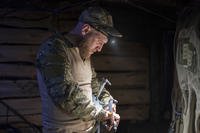FARNBOROUGH, England – The British Royal Air Force plans to finish technological upgrades of as many as 59 Tornado aircraft by 2016 as part of a modernization plan to keep the plane relevant as the F-35 and Typhoon come on line, officials said at the Farnborough International Airshow.
The upgrades included outfitting the planes with precision weapons, improved information exchange and secure communication technology, said Dave Waddington, Tornado Force Commander, RAF.
Although at least eight upgraded Tornado aircraft have recently served in Afghanistan, the RAF plans to fully phase out the plane by 2019 as more Eurofighter Typhoons and F-35s get built, Waddington said.
“The future for the Royal Air Force is F-35 and Typhoon,” Waddington said.
The Tornado GR4 is an all-weather, two-seat attack aircraft which has been in service for more than 30 years. The 17-meter aircraft can reach speeds of Mach 1.3 and altitudes of 50,000-feet.
In addition, the Tornado can fly automatically when vision is obscured due to poor weather by using a terrain following radar, RAF officials said.
The precision-guided bomb upgrade includes efforts to engineer the plane to fire the Paveway IV, a Raytheon-built GPS and laser guided bomb.
“The precision guided bomb capability was absolutely key to Tornado. It gives us that ability to strike a target with the precision that is demanded. It is not just about the weapon itself -- a key element was the integration,” Waddington explained.
Secure radio communications are also integral to the upgrades in order to allow Tornado crews to safely communicate with one another and allied forces.
“This gives us the ability to share voice with our allies that is secure and anti-jammable,” he added.
A digital data link called Link 16 is also part of the upgrade, as it allows Tornado crews to share combat relevant information such as targeting data. Link 16 is the system most U.S. aircraft also use.
“Secure communication allows air crews to speak in a reliable way with forward air controllers and tactical air controllers on the ground -- which means that as soon as they get there they will be able to deliver the necessary effects without the 10 or 15 minutes that it used to take to make sure that you understood the ground situation,” Waddington explained.
If the ground circumstances are understood more quickly then Tornado crews can more quickly deploy whatever force is required in a safe manner, being careful to avoid friendly fire, Waddington added.
Waddington said that the Tornados would retire by 2019 unless the Ministry of Defence’s upcoming defense review winds up changing plans for the RAF, he said.
The first six Tornado’s finished their upgrades in March of last year.








